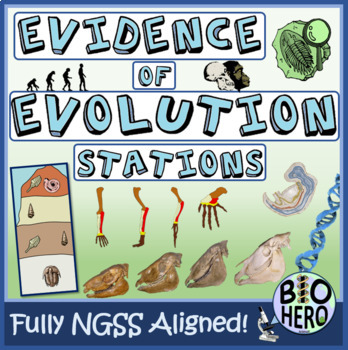Evidence of Evolution Stations
- PDF
What educators are saying
Description
Get your students fully engaged as they travel on a journey to examine fossil evidence, discover how relative dating and radiometric dating work, compare homologous and vestigial structures, embryological evidence, analyze DNA evidence, research antibiotic resistance with a webquest, and even complete a geological time scale. The Evidence of Evolution Stations has students rotating to 8 different stations to analyze these different forms of evidence. Activity is designed for any middle school or high school class studying evolution and takes approximately 3 to 4 (50 minute) class periods to complete all 8 stations. Activity is fully NGSS aligned.
Activity Includes:
- Teacher directions and tips
- Student question guide and Reflection Sheet
- Station Directions and activity materials
- Answer Key
Note to Teachers: I created these stations because I found that I used to just lecture about evolution and have students take notes about all these topics. Although I had a lot of good stuff to share, I was looking for a way to spice up my unit. I wanted students to do some more hands-on learning and exploration with this unit. Pretty soon this activity became the staple of my entire unit. My students loved it, and I'm sure your students will too.
Next Generation Science Standards:
MS-LS4-1: Analyze and interpret data for patterns in the fossil record that document the existence, diversity, extinction, and change of life forms throughout the history of life on Earth under the assumption that natural laws operate today as in the past.
MS-LS4-2: Apply scientific ideas to construct an explanation for the anatomical similarities and differences among modern organisms and between modern and fossil organisms to infer evolutionary relationships.
MS-LS4-3: Analyze displays of pictorial data to compare patterns of similarities in the embryological development across multiple species to identify relationships not evident in the fully formed anatomy.
Thank you for your interest. As always, please rate and follow me for all my updates and new activities.
Thank you,
BioHero
(Brian Sanford)




